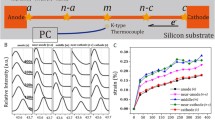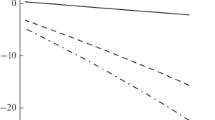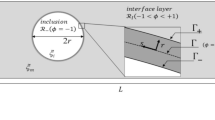Abstract
To improve the fundamental understanding of alloying effects in electromigration, in particular of Cu addition to Al conductor lines, the electromigration process in the grain boundary of an Al-Cu alloy is simulated using a 2D kinetic Monte Carlo method. These simulations give the fluxes of Al and Cu from microscopic parameters, which determine the probability of each atomic jump. The parameters used in these simulations are the diffusion barriers, the attempt frequencies, the electromigration driving force, the temperature, the Cu concentration, and the binding energy of a Cu-vacancy pair. Values for the electromigration driving force on Al and Cu atoms are calculated ab initio. A very interesting result of the kinetic Monte Carlo studies is that the Al flux is reversed due to the addition of a small amount of Cu if the binding energy for the Cu-vacancy pair is larger than 0.12 eV. Such an Al back flux can explain the strongly inhibiting effect of Cu on electromigration damage initiation and transport in Al.
Similar content being viewed by others
References
M. A. Korhonen, P. Borgesen, K. N. Tu. and C.-Y. Li, J. Appl. Phys. 73, 3790 (1993).
J. R. Lloyd and J. J. Clement, Appl. Phys. Lett. 69, 2486 (1996).
J. P. Dekker, P. Gumbsch, E. Arzt. and A. Lodder, Phys. Rev. B 59, 7451 (1999).
R. Rosenberg, J. Vac. Sci. Tech. 9, 263 (1972).
T. Hoshino, R. Zeller. and P. H. Dederichs, Phys. Rev. B 53, 8971 (1996).
T. Hoshino, R. Zeller, P. H. Dederichs. and T. Asada, Physica A 237-238, 361 (1997).
C. Elsässer et al., J. Phys. Cond. Mat. 2, 4371 (1990).
K.-M. Ho, C. Elsässer, C. T. Chan. and M. Fähnle, J. Phys. Cond. Mat. 4, 5189 (1992).
B. Meyer, C. Elsässer. and M. Fähnle, FORTRAN90 Program for Mixed-basis Pseudopotential Calculations for Crystals, Max-Planck-Institut für Metallforschung Stuttgart (unpublished).
R. S. Sorbello, A. Lodder. and S. J. Hoving, Phys. Rev. B 25, 6178 (1982).
C. Bosvieux and J. Friedel, J. Phys. Chem. Solids 23, 123 (1962).
J. P. Dekker, A. Lodder. and J. van Ek, Phys. Rev. B 56, 12167 (1997).
R. S. Sorbello, Mat. Res. Soc. Symp. Proc. 225, 3 (1991).
G. Martin, P. Bellon. and F. Soisson, Sol. State Phen. 42-43, 97 (1995).
Author information
Authors and Affiliations
Rights and permissions
About this article
Cite this article
Dekker, J.P., Elsässer, C. & Gumbsch, P. Simulation of Electromigration Induced Atomic Transport in Al−Cu Alloys. MRS Online Proceedings Library 563, 65–70 (1999). https://doi.org/10.1557/PROC-563-65
Published:
Issue Date:
DOI: https://doi.org/10.1557/PROC-563-65




